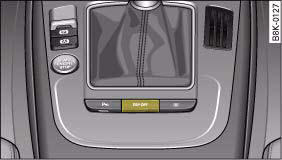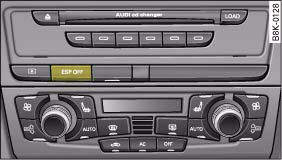General notes
The electronic stabilisation program increases the car's stability on the road.

Fig. 192 Without MMI: Centre console with ESP switch

Fig. 193 Centre console with ESP switch
The ESP is designed to enhance the control over the vehicle in critical handling situations, such as when accelerating and cornering.
It reduces the tendency to skid under all road conditions and improves the stability and roadholding of the vehicle. The system works at all speeds.
The anti-lock brake system (ABS), the electronic differential lock (EDL) and the traction control system (ASR) are all integrated into the electronic stabilisation program.
How the system works
The ESP control unit processes data from the three integrated systems. It also processes additional inputs provided by other highprecision sensors. These register the vehicle's rotation about the vertical axis (yaw rate), lateral acceleration, brake pressure and steering wheel angle.
The system uses the steering wheel angle and road speed to calculate the changes of direction intended by the driver, and constantly compares them with the actual behaviour of the vehicle. If the desired course is not being maintained (for instance, if the car is starting to skid), then the ESP compensates automatically by braking the appropriate wheel.
The forces acting on the braked wheel effectively bring the car back to a stable condition. If the car is oversteering (rear wheels losing grip first) the brake application is concentrated on the outside front wheel; if the car is understeering (front wheels losing grip first), ESP brakes the inside rear wheel. This automatic brake application is accompanied by characteristic noises.
The ESP works in conjunction with the ABS. If a malfunction should occur in the ABS, the ESP will also be out of action.
Switching on
The ESP is switched on automatically when the engine is started and performs a self-test routine. As soon as this routine is complete, the system switches back to normal operating mode. You can press the button ⇒ fig. 192 or ⇒ fig. 193 to switch on the ESP or traction control system (ASR) if they have been switched off. The message ESP/ASR on will appear briefly in the display.
Switching off
The ESP should normally be left switched on at all times. If required, you can press the ESP OFF button to switch off the traction control system (ASR) or the electronic stabilisation program (ESP).
Х Switching off the traction control system (ASR): Press the ESP
button briefly. The traction control system (ASR) can be switched off
in special driving conditions, e.g. if you are driving with snow chains. The
message ASR off will appear in the display.
Х Switching off the ESP/traction control system (ASR): Press the
ESP button for longer than 3 seconds. The ESP/ASR warning lamp
lights up when the system is switched off. The
message ESP switched off will appear in the display.
 WARNING
WARNING
Х The ESP is not able to overcome the physical limits of adhesion.
Even with ESP, you should always adjust your speed to suit the
conditions. Please bear this in mind, especially on wet or slippery
road surfaces. Do not let the extra safety provided tempt you into
taking any risks when driving Ц this can cause accidents.
Х Please note that, when the ESP or ESP/traction control system
(ASR) is switched off, the driven wheels may start to spin, causing
the vehicle to lose grip, in particular on slippery or wet roads -
danger of skidding!
